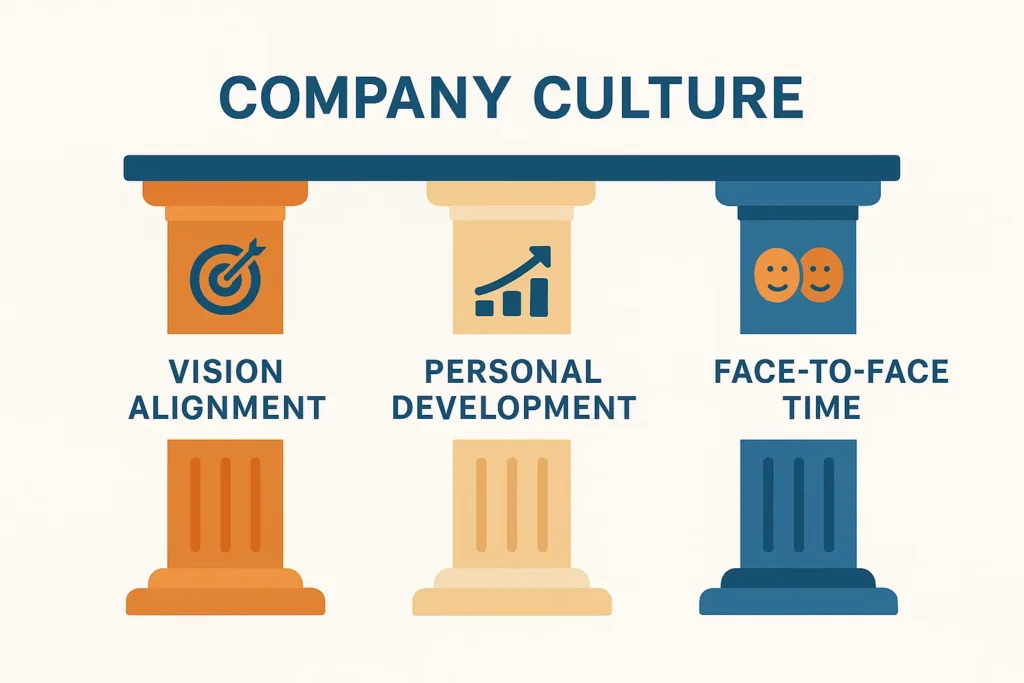Company culture isn’t built on free snacks or ping‑pong tables. It’s forged through clear vision alignment, meaningful personal development, and intentional face‑to‑face time.
I enjoy watching Joshua Fluke’s videos that roast company culture, especially where culture comes at the cost of the employee, but I have come to realise how important it has been to get everyone in our company pulling in the same direction.
A lot of business owners insist on creating a culture by essentially trapping employees in a hedonistic prison. To elaborate, I mean that business owners essentially think that they need to provide their employees with endless perks that both entertain their employees and keep them sucking at the teat – completely dependent on the business.
What I’ve learnt is that creating this community and culture around the workplace really boils down to 3 things:
- Aligning the team with your company’s vision, mission and values
- Understanding what team members value and want to achieve
- Seeing each other in person and building a strong relationship
All these other company perks are secondary, and might even attract the wrong people, especially if hiring processes do not filter out the wrong type of people.

Aligning Team Values
Aligning your team with the company’s vision, mission, and values is the most important aspect of building culture at a company. It all starts at the hiring stage. You need to identify candidates who fit. This doesn’t mean hiring ‘yes men’, but it entails finding people who want to bring the company’s vision to life.
As a leader, you need to embody the vision, mission and values of the company and be passionate about seeing this vision come to life – who will follow a leader without passion?
Your team members need to be skilled, sure, but most importantly, hire for their attitude and not their skill.
You want them to show fierce dedication because they care. Of course, they will need to be compensated for their time, and depending on their skills and performance, they should be compensated accordingly, but never fall for the trap of paying a high wage to someone who simply does not care, even if they have all the skills.
That person will always bring the rest of the team down – energy is so important. Even when I’m passionate about something, it sometimes takes only one individual bringing negative energy to bring me down to their level. It’s like the saying “one bad apple spoils the barrel”.
Understanding Team Members
Understanding your team is a real test as a leader.
Try this exercise – I’m sure it will be difficult. Look at each member in your team and write down their strengths and weaknesses. Then write how you see them evolving in the next 5 years. Do you see them developing, moving on, or staying stagnant? Your view of your team will say a lot about how well you understand their motivations, and whether you’re nurturing the paths they genuinely care about.
The simplest way to close any gaps is to ask, then listen.
Grab coffee one‑on‑one, skip the corporate questionnaire and have a real conversation:
- “When you picture your career in three years, what excites you?”
- “Which parts of your current role drain you? Which parts light you up?”
- “What skills are you itching to learn next?”
You’ll hear wildly different answers—some want a clear promotion ladder, others crave mastery in a niche craft, a few dream of launching their own venture one day. All are valid. Your job isn’t to promise everything; it’s to map what the company can offer to what each person values. That might be:
- Pairing a budding leader with a seasoned mentor.
- Carving out Friday R&D time for the tinkerer.
- Funding a part‑time UX course for the designer who lights up around user research.
When people feel you’re invested in their scoreboard, they’ll fight for yours.
Face‑to‑Face Time > Foosball Tables
Which brings me to the last pillar: seeing each other in person and building a real relationship.
I’m all for remote flexibility, but no Slack thread or Zoom stand‑up replicates the sparks that fly when the team rubs shoulders in the same room. The trick is to make those meet‑ups intentional rather than obligatory.
- Quarterly On‑Sites: Two days where we hash out strategy in the morning, solve problems in cross‑functional squads after lunch, and cook dinner together that evening. (Amazing what chopping onions next to someone does for rapport.)
- Monthly “Show‑Don’t‑Tell” Demos: Everyone, even Ops and Finance, gets five minutes to demo something they built, fixed or learned. Applause mandatory, heckling encouraged.
- Walking 1:1s: Ditch the conference room. Fresh air drops defenses and raises candor.
Those moments create shared stories. Shared stories breed trust. Trust propels execution faster than any perk ever will.
Kill the Candy, Keep the Core
None of these bans nice extras—good coffee, health stipends, the occasional off‑site at a countryside barn. But perks should be condiments, not the meal. When culture is built on alignment, understanding and real relationships, employees won’t stick around for the free doughnuts; they’ll stay because the work matters and the people around them elevate their game.
Joshua Fluke can keep roasting the “hedonistic prisons.” I’ll be over here investing in mission‑driven hires, learning their north stars, and making sure we get face time that fuels trust. Funny thing: that costs less than a slide in the lobby and returns more than any sugar‑coated perk ever will.


